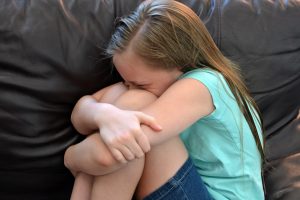Tantrums Aren’t Just for Toddlers
When you have little ones, there is a lot of talk about how “it’s just a phase” and “this too shall pass,” whether it’s about picky eating, tantrums, or some other behavior deemed inappropriate in our society.
While it is true that many of those behaviors do pass with time, I definitely wasn’t expecting to still witness full toddler-style tantrums with my child at 8 years old.

I guess it isn’t that surprising, since I will admit to having my own “tantrums” at times and I’m an adult. I get overwhelmed, hurt, or disappointed, and one more upset can easily be the straw that breaks the camel’s back. Sometimes I get mad and I’ll take a time-out to calm down and get it together.
But as our kids get older, our expectations for their behavior change, and we can be surprised when they have moments where they act much younger than their chronological age. An older child may lash out physically, hitting or kicking something or someone. Maybe they freak out about something that seems like no big deal, but it pushes them over the edge for whatever reason. Perhaps they refuse to share or cooperate.
How should we respond when an older child behaves like a toddler?
Conventional advice may say to give tough love and just not accept the behavior:
“Don’t let them get away with that!” “Nip it in the bud.” Then insert some consequence, like sending them to their room, grounding them, or taking away privileges.
Or maybe we hear that we should just ignore the child:
“Ignore her and pay no attention, or she’ll learn that the bad behavior works and will keep doing it for attention.”
These responses are similar to what parents often hear regarding toddler tantrums, but they are no more valid when a child is older than when they are younger. Neither doling out consequences nor ignoring an obviously upset child (of any age) is an appropriate parental response to a tantrum. But first, let’s discuss what a tantrum actually is.

What exactly is happening here?
The first thing to always consider is the child’s basic needs (food, rest, safety, etc.) Just like when they are little, we must remember that older children may be tired from staying up late, or hungry if perhaps they forgot to eat. Maybe they are going through a growth spurt and just need to be eating more food to support that growth. None of us are on our best behavior when our basic needs aren’t met, so teaching older children to listen to their bodies and take a break or get a snack when they start to feel “that feeling” coming on can be helpful.
But even when the basic needs are met, tantrums can still happen. With my years of experience working with Rebecca and reading her books, as well as Pam Leo’s book (and tele-class) Connection Parenting, I have learned that this behavior that we may call a meltdown or a tantrum is really just an outward expression of internal overwhelm.
And outward expression of internal overwhelm.
Something has happened to push the child past the point where she could handle her feelings, and those feelings come exploding out. Pam Leo says the child’s “hurts cup” got too full and had to be dumped. Children have big feelings inside their little bodies and they can only handle so much before it spills over.
This seems simple enough to understand when it comes to toddlers, because they are so little. Their communication skills are not well developed so they can easily get frustrated just trying to get their caregivers to understand what they need or want. Their physical skills are still developing so they can’t actually do all of the things they want to do, or they aren’t allowed to do things due to safety concerns. We get it when toddlers melt down and usually, if we can keep our own cool, we can help them through it.
But when it’s an older child, it can be difficult to remember that there is still a very young person inside who needs our unconditional love and support through these big feelings. In that moment, it really is not so different from supporting a toddler.

Should they go to their rooms until they calm down?
My kids will sometimes go to a room to be alone and cry or yell, and that’s ok, because it’s their choice. It’s something I’ve taught them they are allowed to do – they can take a break – and then let me know when they want me to come in or just come to me. But I don’t take them there and make them stay there alone. I didn’t put them in time-out when they were little because, in our house, time-outs are for taking, not giving. I think that is another lovely bit I learned from Pam Leo.
For me, I feel like sending them to be alone sends a message that I only want to be with them when they are acting pleasantly, and that just isn’t true. As I told my daughter that morning, I am here for her all the time, whether she is happy or sad, having fun or feeling mad. I will always be there for her and I want her to know she can come to me and get comfort even when she isn’t acting nicely.
This is tough stuff. It takes a lot of emotional energy and practice. But it’s so worth it
It’s all about the relationship
Our responses to our children’s big feelings are a huge part of the relationship we are building with them. Remember that this is not about you personally, but about something going in inside of them. Recognize when a child needs someone to not be talking to him. Talking to him when he can’t hear anyway is definitely not helpful, but there is an in-between option that works really well for us – just staying present and quiet. And usually low, like sitting on the floor.
When mine were little (and actually I did this recently when my 8-year-old daughter melted down, so it doesn’t really expire!) I would just stay close by where they could see, sit on the floor, and take slow deep breaths. If I could get a word in here or there I might say “I’m here when you’re ready” and if not, let them see me sitting calmly with open arms if they looked over. When they were ready, they would come over for comfort. But they knew I was there the whole time, and doing this showed them that their feelings were ok and nothing to hide, and that I would be there for them even when they were at their worst.

Empathy
That day with my daughter, I ended up crying *with her* when she told me that no one understood how she felt, because I really could connect with that feeling. I have felt that way too, and it’s a very sad, lonely feeling. I actually cried some pretty hard tears of my own just remembering how sad it is to feel that way.
Actually, I wasn’t remembering the feeling. I was feeling the feeling. I was feeling my own pain, as well as her pain, in that moment.
That is seriously connecting when you can empathize and cry with your child. I often refer to this moment of connection as “where the magic happens” because it is truly an amazing point to reach. When you can put yourself in the other person’s position, and truly see and feel it from their point of view…. wow.
On this day, once I got to that point of empathy, she calmed down quickly and we were able to hug, get ourselves all back together, and move on with our day. It was truly healing for both of us.
You see, the thing about the tantrum is that it’s an outward expression of that internal sadness, and once someone is willing to feel the pain with you, you are truly validated. That validation means that there’s no longer a need for the tantrum. That’s why she calmed so quickly. She didn’t need to keep expressing the pain because she wasn’t carrying it alone anymore. I got in the pit with her and felt the sadness with her, and then she was able to move through it and the tantrum was done.
5 tips for handling tantrums with children of any age
1. Stay close by. Don’t send a child to his room to be alone. It’s ok if the child goes on his own and asks to be alone, but don’t force isolation. I recommend staying low, sitting on the floor near the child.
2. Give space. Stay close, but not too close, especially if the child is acting out physically and you’d be in danger of being hit or kicked if you were too close. Also, if the child responds by moving further away, you should give a little more space.
3. Take slow, deep breaths. Notice how you feel, yourself. If you feel your own strong emotions when your child is expressing his, pay attention to that. Your own reactions during your child’s tantrum can give you clues that may be helpful.
4. Speak gently. When you feel it’s time to offer words, speak softly and without judgment. “I’m sorry you’re sad.” “I’m sorry this happened.” “I love you.”
5. Invite touch. Let them know they can come to you when they are ready. Ask if you can give a hug or hold the child. That may be too much at first, so asking if you can touch a hand or a foot may be a good first step to connect physically.
It’s ok to feel sad
I want to be clear that these tips are not about making things right when a child isn’t happy. We aren’t just trying to make the tantrum stop. This is about it being OK to not be happy.
It’s not our job to keep our children from feeling sad, and we shouldn’t try to make their sadness go away. This is about showing them unconditional love when they are sad or angry. It’s about showing them how to handle those feelings in a healthy way (expressing them, not shutting them down or holding them in), and going to a trusted person to share their big emotions. These are healthy things to teach little people, so that when they are big and their problems are big, they have the skills they learned when they were little.
I believe that teens and adults who did not learn to handle their emotions and problems, and turn to a trusted friend or parent, can end up turning to other negative things to handle their feelings (food, drugs, alcohol, etc.) and often to people who seem to understand them but are not good influences. We are building a long-term relationship with our children and that includes building trust when they are having a hard time.
This is not about soothing and calming and just trying to make everything ok. It’s about truly understanding where they are and being willing to get down into that pit with them and just be with them, accepting them and their feelings without judgment. This should not be mistaken for making things right and avoiding sadness.

This is hard for us to do, as parents
 When we, as parents, have a hard time with a situation we find ourselves in with our children, it can be helpful to reflect on how things were for us when we were growing up. If my house was not a safe place to have big feelings, if I was sent to my room to cry and not listened to or understood, if I was told it wasn’t ok to be angry or cry or whatever, then it will be very uncomfortable for me when my child expresses those emotions and behaviors. (This is from Consciously Parenting Book III: Nurturing Connection, chapter 3.)
When we, as parents, have a hard time with a situation we find ourselves in with our children, it can be helpful to reflect on how things were for us when we were growing up. If my house was not a safe place to have big feelings, if I was sent to my room to cry and not listened to or understood, if I was told it wasn’t ok to be angry or cry or whatever, then it will be very uncomfortable for me when my child expresses those emotions and behaviors. (This is from Consciously Parenting Book III: Nurturing Connection, chapter 3.)
So a huge part of parenting is reflecting on what happened to me when I was my child’s age, and learning from that. We all do it at some point. Usually we think about how we were parented, and we either decide we are not going to parent like our parents did, or other times we decide to do things the same way. Often it’s a combination.
But when things are hard, and we are stressed, we will usually revert back to whatever was done to us. As Pam Leo says, our experiences were recorded for us and when we are in a similar situation we will usually play those recordings, often even using the same words our parent used.
Healing work
The good news here is that, while parenting can be hard and even painful at times, when experiences and feelings from our own childhood are brought back up, it is also very healing. When we treat our children the way they deserve to be treated when they are expressing feelings, this is also the way we deserved to be treated when we were children. In effect, we can give that to ourselves and help to heal those long-lost hurts.




